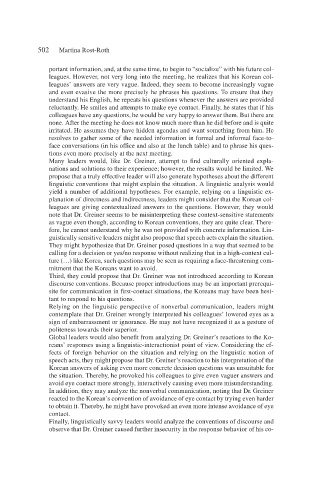Page 524 - Handbooks of Applied Linguistics Communication Competence Language and Communication Problems Practical Solutions
P. 524
502 Martina Rost-Roth
portant information, and, at the same time, to begin to “socialize” with his future col-
leagues. However, not very long into the meeting, he realizes that his Korean col-
leagues’ answers are very vague. Indeed, they seem to become increasingly vague
and even evasive the more precisely he phrases his questions. To ensure that they
understand his English, he repeats his questions whenever the answers are provided
reluctantly. He smiles and attempts to make eye contact. Finally, he states that if his
colleagues have any questions, he would be very happy to answer them. But there are
none. After the meeting he does not know much more than he did before and is quite
irritated. He assumes they have hidden agendas and want something from him. He
resolves to gather some of the needed information in formal and informal face-to-
face conversations (in his office and also at the lunch table) and to phrase his ques-
tions even more precisely at the next meeting.
Many leaders would, like Dr. Greiner, attempt to find culturally oriented expla-
nations and solutions to their experience; however, the results would be limited. We
propose that a truly effective leader will also generate hypotheses about the different
linguistic conventions that might explain the situation. A linguistic analysis would
yield a number of additional hypotheses. For example, relying on a linguistic ex-
planation of directness and indirectness, leaders might consider that the Korean col-
leagues are giving contextualized answers to the questions. However, they would
note that Dr. Greiner seems to be misinterpreting these context-sensitive statements
as vague even though, according to Korean conventions, they are quite clear. There-
fore, he cannot understand why he was not provided with concrete information. Lin-
guistically sensitive leaders might also propose that speech acts explain the situation.
They might hypothesize that Dr. Greiner posed questions in a way that seemed to be
calling for a decision or yes/no response without realizing that in a high-context cul-
ture (…) like Korea, such questions may be seen as requiring a face-threatening com-
mitment that the Koreans want to avoid.
Third, they could propose that Dr. Greiner was not introduced according to Korean
discourse conventions. Because proper introductions may be an important prerequi-
site for communication in first-contact situations, the Koreans may have been hesi-
tant to respond to his questions.
Relying on the linguistic perspective of nonverbal communication, leaders might
contemplate that Dr. Greiner wrongly interpreted his colleagues’ lowered eyes as a
sign of embarrassment or ignorance. He may not have recognized it as a gesture of
politeness towards their superior.
Global leaders would also benefit from analyzing Dr. Greiner’s reactions to the Ko-
reans’ responses using a linguistic-interactionist point of view. Considering the ef-
fects of foreign behavior on the situation and relying on the linguistic notion of
speech acts, they might propose that Dr. Greiner’s reaction to his interpretation of the
Korean answers of asking even more concrete decision questions was unsuitable for
the situation. Thereby, he provoked his colleagues to give even vaguer answers and
avoid eye contact more strongly, interactively causing even more misunderstanding.
In addition, they may analyze the nonverbal communication, noting that Dr. Greiner
reacted to the Korean’s convention of avoidance of eye contact by trying even harder
to obtain it. Thereby, he might have provoked an even more intense avoidance of eye
contact.
Finally, linguistically savvy leaders would analyze the conventions of discourse and
observe that Dr. Greiner caused further insecurity in the response behavior of his co-

